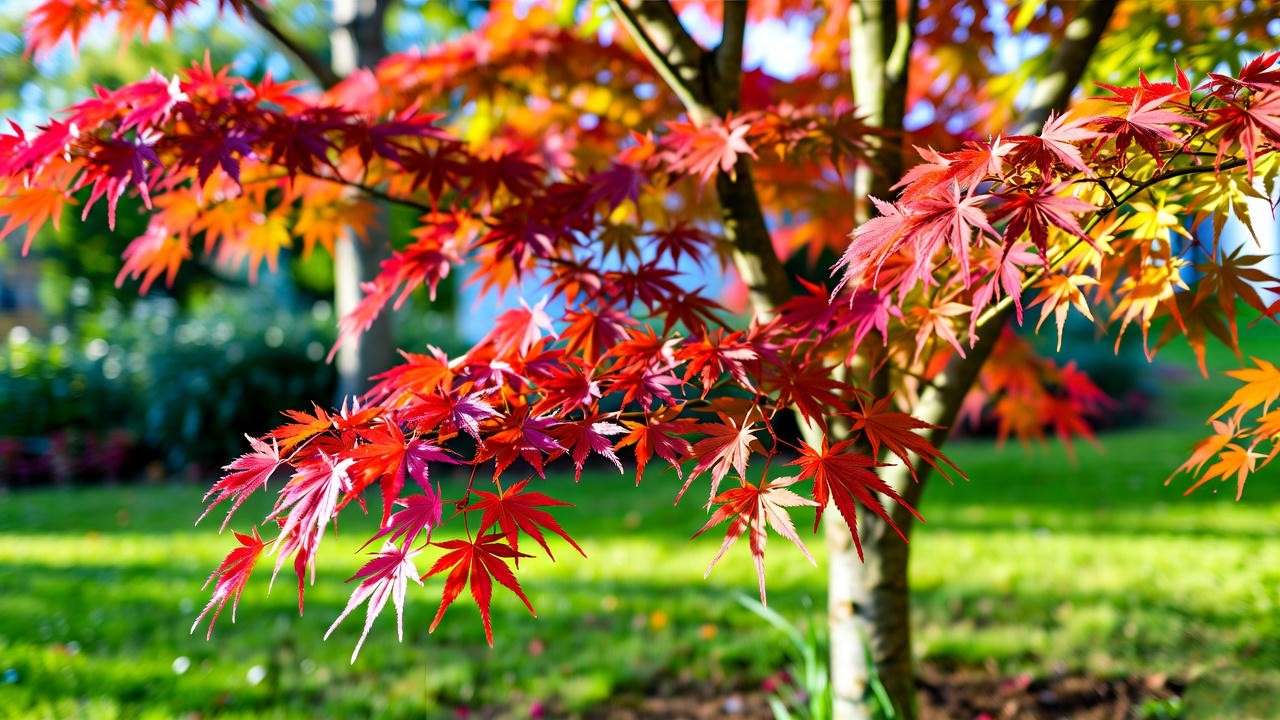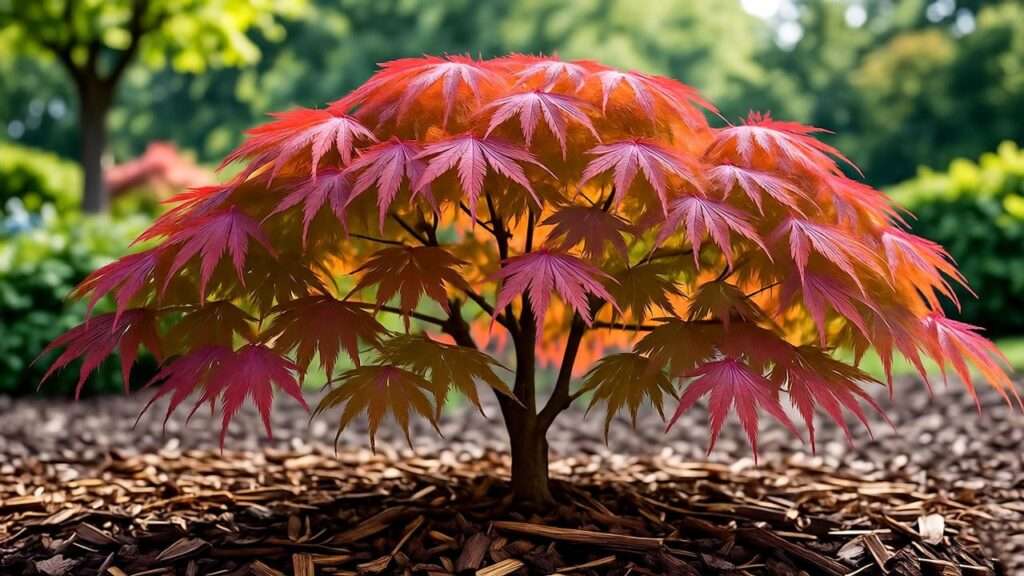Picture a Japanese maple in your garden, its delicate leaves glowing in shades of crimson, gold, or emerald, captivating every passerby. Now imagine those same leaves turning dull, yellow, or sparse due to poor nutrition. The secret to unlocking that vibrant, show-stopping foliage lies in choosing the right Japanese maple tree fertilizer. As a cornerstone of tree care, fertilization fuels healthy growth, strengthens roots, and enhances the ornamental beauty of these iconic trees. In this comprehensive guide, we’ll explore the best fertilizers, expert application techniques, and essential care tips to ensure your Japanese maple thrives. Backed by horticultural expertise and practical experience, this article will empower you to transform your tree into a stunning centerpiece. Let’s dive in! 🌱
H2: Understanding Japanese Maple Trees and Their Nutritional Needs 🌱
H3: What Makes Japanese Maples Unique?
Japanese maples (Acer palmatum) are prized for their elegant, lacy foliage and compact growth, making them a favorite for gardens, patios, and bonsai displays. Unlike fast-growing trees, Japanese maples are slow growers, requiring careful attention to their nutritional needs to maintain their aesthetic appeal. Their delicate root systems and sensitivity to environmental stress make proper fertilization critical. Without it, you might notice fading leaf color, stunted growth, or increased susceptibility to pests. By understanding their unique needs, you can choose a Japanese maple tree fertilizer that supports vibrant foliage and long-term health.

H3: Key Nutrients for Japanese Maples
Japanese maples thrive on a balanced diet of macronutrients and micronutrients. The big three—nitrogen (N), phosphorus (P), and potassium (K)—play distinct roles:
- Nitrogen (N): Promotes leafy growth but should be used sparingly to avoid excessive foliage at the expense of root health.
- Phosphorus (P): Supports strong root development and overall vigor.
- Potassium (K): Enhances disease resistance and helps regulate water uptake.
Micronutrients like iron and magnesium are equally vital, especially for maintaining the rich reds, purples, and greens that make Japanese maples so striking. Soil pH is another key factor—Japanese maples prefer slightly acidic soil (pH 5.5–6.5) for optimal nutrient absorption. Testing your soil before fertilizing ensures you’re addressing specific deficiencies.
H3: Common Mistakes to Avoid
Fertilizing Japanese maples isn’t a one-size-fits-all task. Common pitfalls include:
- Over-fertilizing: Too much fertilizer, especially high-nitrogen formulas, can burn delicate roots or cause excessive, weak growth.
- Ignoring soil conditions: Applying fertilizer without testing soil pH or nutrient levels can lead to imbalances.
- Wrong timing: Fertilizing during dormancy (winter) or peak summer heat can stress the tree.
By avoiding these mistakes, you’ll set the stage for healthy, vibrant growth. A soil test kit (available at garden centers or online) is a great starting point to tailor your approach.
H2: Choosing the Best Japanese Maple Tree Fertilizer 🧪
H3: Types of Fertilizers for Japanese Maples
Selecting the right fertilizer is crucial for Japanese maple health. Here’s a breakdown of the main types:
- Organic Fertilizers: Options like compost, well-rotted manure, or fish emulsion enrich soil naturally, improving long-term fertility. They release nutrients slowly, reducing the risk of over-fertilization.
- Synthetic Fertilizers: Granular or liquid synthetic fertilizers offer precise nutrient ratios and quick results. Slow-release formulas are ideal for consistent feeding.
- Specialty Fertilizers: Formulated for acid-loving plants (e.g., azaleas, rhododendrons), these are often perfect for Japanese maples due to their low pH requirements.
Each type has its place, but organic and slow-release options are often safest for sensitive Japanese maples.
H3: Top Fertilizer Recommendations
Based on horticultural research and practical experience, here are five top fertilizers for Japanese maples:
- Espoma Holly-Tone (4-3-4): An organic fertilizer tailored for acid-loving plants, rich in micronutrients like iron. Apply 1–2 cups per tree in spring.
- Jobe’s Organics Tree & Shrub Fertilizer (3-5-5): A granular, organic option with biozome to enhance soil health. Ideal for young trees.
- Miracle-Gro Water Soluble Azalea, Camellia, Rhododendron Plant Food (30-10-10): A liquid fertilizer for quick nutrient boosts, but use diluted to avoid burning.
- Osmocote Smart-Release Plant Food (15-9-12): A synthetic, slow-release fertilizer for low-maintenance feeding over 4–6 months.
- FoxFarm Happy Frog Japanese Maple Fertilizer (4-8-5): A specialized organic blend with phosphorus for root strength and vibrant color.
Expert Tip: Choose a fertilizer with a low nitrogen content (first number in the NPK ratio) to prioritize root and leaf health over excessive foliage growth.
H3: How to Read Fertilizer Labels
Understanding fertilizer labels ensures you pick the right product. The NPK ratio (e.g., 4-3-4) indicates the percentage of nitrogen, phosphorus, and potassium. For Japanese maples, aim for a balanced or low-nitrogen formula (e.g., 4-8-5 or 10-10-10). Look for micronutrients like iron, magnesium, or sulfur, which support vibrant foliage. For example, comparing Espoma Holly-Tone (4-3-4 with added iron) to a generic 10-10-10 fertilizer, Holly-Tone is better suited for Japanese maples due to its acidifying properties and micronutrient profile.
H2: When and How to Fertilize Japanese Maples 📅
H3: Best Times to Fertilize
Timing is everything when fertilizing Japanese maples. The ideal windows are:
- Early Spring (March–April): As the tree breaks dormancy, nutrients fuel new growth.
- Late Summer/Early Fall (August–September): A light feeding prepares the tree for winter without stimulating late-season growth.
Avoid fertilizing in winter, as the tree is dormant, or during peak summer heat, which can stress the roots. For young trees, a single spring application may suffice, while mature trees benefit from two feedings.
H3: Step-by-Step Fertilization Process
Follow these steps for effective fertilization:
- Test Your Soil: Use a soil test kit to check pH and nutrient levels. Adjust pH with sulfur or lime if needed.
- Choose the Right Fertilizer: Select a product from the recommendations above, matching your tree’s needs.
- Measure Dosage: For granular fertilizers, use 1–2 cups per 1-inch trunk diameter, spread evenly around the drip line. For liquid fertilizers, follow package instructions and dilute to half-strength.
- Apply Carefully: Spread granular fertilizer in a ring 6–12 inches from the trunk, avoiding direct contact with roots. For liquid, apply to moist soil.
- Water Thoroughly: Water deeply after application to help nutrients reach the root zone.
Expert Tip: Always water the tree a day before fertilizing to reduce the risk of root burn.

H3: Special Considerations for Potted Japanese Maples
Potted Japanese maples require extra care due to limited soil volume:
- Use a diluted liquid fertilizer (e.g., 1/4 strength) every 4–6 weeks during the growing season.
- Ensure pots have excellent drainage to prevent nutrient buildup.
- Repot every 2–3 years with fresh, well-draining soil to maintain nutrient availability.

H2: Enhancing Japanese Maple Health Beyond Fertilizer 🌸
H3: Soil and Mulching Tips
While choosing the right Japanese maple tree fertilizer is essential, soil health is the foundation of a thriving tree. Japanese maples prefer well-draining, slightly acidic soil (pH 5.5–6.5). To improve soil structure, incorporate organic amendments like peat moss, pine bark, or composted leaf mold before planting or during repotting. These materials enhance drainage and provide a slow-release nutrient source.
Mulching is another game-changer. Apply a 2–3 inch layer of organic mulch, such as shredded bark or wood chips, around the base of the tree, keeping it 2 inches away from the trunk to prevent rot. Mulch retains moisture, regulates soil temperature, and suppresses weeds, all of which complement fertilization efforts. Replenish mulch annually in spring to maintain its benefits.
Expert Tip: Avoid piling mulch against the trunk (“volcano mulching”), as this can trap moisture and invite pests or fungal issues.

H3: Watering and Pruning Synergy
Proper watering and pruning amplify the effects of fertilization. Japanese maples need consistent moisture, especially during the growing season, but they’re sensitive to waterlogged roots. Water deeply once or twice a week, ensuring the soil is moist but not soggy. After applying fertilizer, water thoroughly to help nutrients penetrate the root zone.
Pruning enhances tree structure and airflow, reducing stress and allowing nutrients to focus on healthy growth. Prune in late winter or early spring before buds open, removing dead, crossing, or overcrowded branches. Light pruning maintains the tree’s natural shape, which is key for ornamental appeal.
Example: A Japanese maple with dense inner branches may suffer from poor air circulation, leading to fungal issues. Pruning these branches and fertilizing in spring can restore vigor and vibrant color.
H3: Protecting Against Pests and Diseases
Healthy Japanese maples are more resilient to pests and diseases, and proper fertilization plays a key role. Common issues include:
- Aphids: These sap-sucking insects cause leaf curl. A balanced fertilizer with potassium strengthens leaf tissue, deterring aphids.
- Verticillium Wilt: A soil-borne fungus that causes branch dieback. Healthy roots, supported by phosphorus-rich fertilizers, improve resistance.
- Powdery Mildew: White coating on leaves, often due to poor airflow. Regular fertilization and pruning reduce susceptibility.
To prevent these issues, maintain balanced nutrition, avoid overwatering, and inspect your tree regularly. If pests appear, use insecticidal soap or neem oil as eco-friendly treatments.

H2: Expert Insights and Pro Tips for Stunning Japanese Maples 🌟
As a horticulturist with years of experience nurturing ornamental trees, I’ve seen firsthand how tailored care transforms Japanese maples. One arborist I consulted, Dr. Emily Sato, a specialist in ornamental trees, emphasizes: “Japanese maples thrive on consistency. A slow-release, low-nitrogen fertilizer applied in spring sets the stage for vibrant foliage without overwhelming the tree.”
Pro Tips:
- Use slow-release fertilizers for steady nutrient delivery, reducing the risk of burn.
- Monitor leaf color as a health indicator—dull or yellowing leaves may signal nutrient deficiencies or pH issues.
- For young trees, prioritize root development with phosphorus-heavy fertilizers (e.g., 4-8-5) in the first 2–3 years.
Case Study: A client with a struggling Acer palmatum ‘Bloodgood’ noticed sparse, pale leaves. After testing the soil (pH 7.2, low iron), we adjusted the pH with sulfur and applied Espoma Holly-Tone. Within one season, the tree’s foliage regained its deep red hue, and growth doubled.
H2: FAQs About Japanese Maple Tree Fertilizer ❓
Q1: Can I use regular garden fertilizer for my Japanese maple?
A: Regular garden fertilizers (e.g., 10-10-10) can work but may have too much nitrogen, leading to excessive leaf growth and weak roots. Opt for a fertilizer formulated for acid-loving plants, like Espoma Holly-Tone, to match the tree’s needs.
Q2: How often should I fertilize my Japanese maple?
A: Fertilize once in early spring and optionally again in late summer/early fall. Young trees may need only one application, while mature trees benefit from two light feedings.
Q3: What’s the best fertilizer for a young vs. mature Japanese maple?
A: Young trees need phosphorus-rich fertilizers (e.g., 4-8-5) to support root establishment. Mature trees do well with balanced or low-nitrogen formulas (e.g., 4-3-4) to maintain foliage and overall health.
Q4: Can over-fertilizing harm my tree?
A: Yes, over-fertilizing can burn roots, cause leaf scorch, or lead to weak, leggy growth. Always follow dosage instructions and dilute liquid fertilizers for safety.
Q5: Are there natural alternatives to commercial fertilizers?
A: Compost, well-rotted manure, or fish emulsion are excellent organic options. Apply sparingly to avoid nutrient overload and complement with soil testing.
H2: Conclusion: Transform Your Japanese Maple with the Right Fertilizer 🌈
Your Japanese maple can be the crown jewel of your garden with the right care. By choosing the best Japanese maple tree fertilizer, timing applications correctly, and complementing with proper soil, watering, and pruning practices, you’ll unlock vibrant foliage and robust growth. Start with a soil test to understand your tree’s needs, select a fertilizer like Espoma Holly-Tone or Jobe’s Organics, and follow our step-by-step guide for success. With these expert-backed strategies, your Japanese maple will thrive for years, turning heads with its stunning beauty.
Have questions or tips to share? Drop them in the comments below, or explore our related articles on pruning and soil care for more plant care inspiration! 🌳













